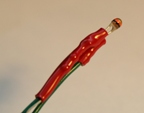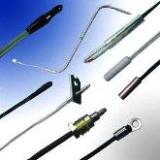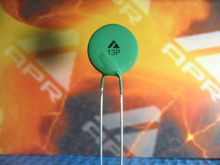Thermal resistances and their use
 When an electric current flows, heat is generated in the wire. Some of this heat goes to heating the wire itselfthe other part is released into the environment by convection, heat conduction (conductors and carriers) and radiation.
When an electric current flows, heat is generated in the wire. Some of this heat goes to heating the wire itselfthe other part is released into the environment by convection, heat conduction (conductors and carriers) and radiation.
In a stable thermal equilibrium, the temperature and, accordingly, the resistance of the conductor depend both on the magnitude of the current in the conductor and on the causes that affect the transfer of heat to the environment. These reasons include: the configuration and dimensions of the wire and fittings, the temperature of the wire and the medium, the velocity of the medium, its composition, density, etc.
The dependence of the resistance of the conductor on temperature, the speed of movement of the environment, its density and composition can be used to measure these non-electric quantities by measuring the resistance of the conductor.
 The conductor intended for the specified purpose is a measuring transducer and is called thermal resistance.
The conductor intended for the specified purpose is a measuring transducer and is called thermal resistance.
For the successful use of thermal resistance to measure non-electric quantities, it is necessary to create conditions in which the measured non-electric quantity has the greatest influence on the thermal resistance values, while other quantities, on the contrary, would not, if possible, affect the its sustainability.
When using thermal resistance, one should aim to reduce heat transfer by wire conduction and radiation.
With a wire length significantly exceeding its diameter, the recoil through the thermal conductivity of the wire can be neglected if the temperature difference between the wire and the medium does not exceed 100 ° C. If the indicated heat returns cannot be neglected, they are taken into account in the calibration .
Thermal resistance devices for measuring gas (air) flow velocity are called hot-wire anemometers.
The thermal resistance is a thin wire whose length is 500 times the diameter.
If we place this resistance in a gas (air) medium of constant temperature and pass a constant current through it, then, assuming that heat is released only by convection, we obtain the dependence of the temperature, and hence the magnitude of the thermal resistance, on the speed of movement of the gas (air) flow...
 Instruments are called for measuring temperatures, where thermal transfers are used as transducers resistance thermometers… They are used to measure temperatures up to 500 °C.
Instruments are called for measuring temperatures, where thermal transfers are used as transducers resistance thermometers… They are used to measure temperatures up to 500 °C.
In this case, the RTD temperature should be determined by the temperature of the measured medium and should not depend on the current in the transducer.
Heat resistance should get rid of materials with high temperature coefficient of resistance.
The most commonly used platinum (up to 500 ° C), copper (up to 150 ° C) and nickel (up to 300 ° C).
For platinum, the dependence of resistance on temperature in the range of 0 — 500 ° C can be expressed by the equation rt = ro NS (1 + αNST + βNST3) 1 / degree, where αn = 3.94 x 10-3 1 / degree, βn = -5.8 x 10-7 1 / deg
For copper, the dependence of resistance on temperature within 150 ° C can be expressed as rt = ro NS (1 + αmT), where αm = 0.00428 1 / deg.
 The dependence of nickel resistance on temperature is determined experimentally for each brand of nickel, since its temperature coefficient of resistance can have different values, and in addition, the dependence of nickel resistance on temperature is non-linear.
The dependence of nickel resistance on temperature is determined experimentally for each brand of nickel, since its temperature coefficient of resistance can have different values, and in addition, the dependence of nickel resistance on temperature is non-linear.
Thus, by the magnitude of the resistance of the converter, it is possible to determine its temperature and, accordingly, the temperature of the environment in which the thermal resistance is located.
The thermal resistance in resistance thermometers is a wire wound on a frame made of plastic or mica, placed in a protective shell, the dimensions and configuration of which depend on the purpose of the resistance thermometer.
Any resistance thermometer can be used to measure resistance.
to measure temperatures, also use bulk semiconductor resistances with a temperature coefficient of resistance about 10 times greater than that of metals (-0.03 — -0.05)1/hail.
Semiconductor heat resistance (MMT type) manufactured by Ivay are produced by ceramic methods from various oxides (ZnO, MnO) and sulfur compounds (Ag2S).They have a resistance of 1000 — 20,000 ohms and can be used to measure temperatures from -100 before + 120 ° C.
